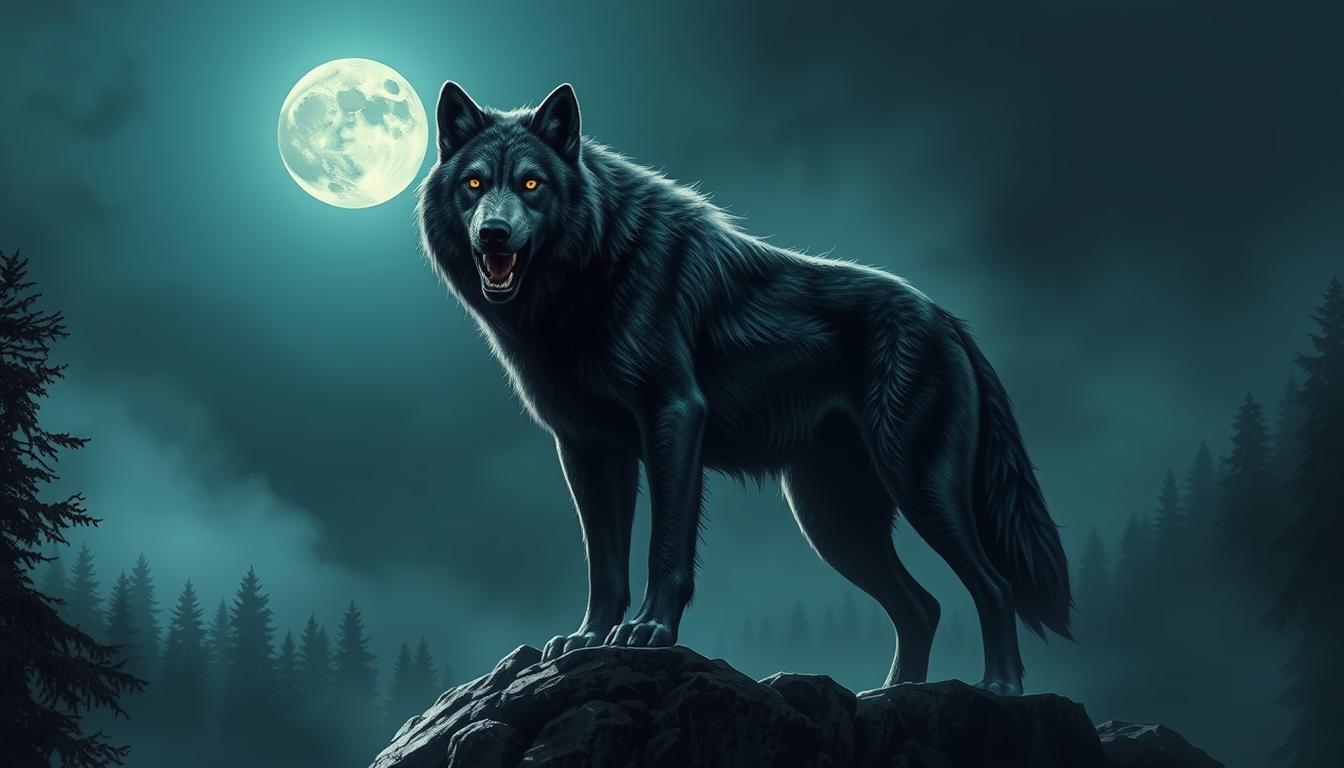Imagine yourself in a moonlit forest, hearing a wolf’s howl. For thousands of years, werewolf legends have fascinated us. But have you ever thought, do these shape-shifters really exist? We’ll look into the origins and lasting charm of werewolf myths. We’ll separate fact from fiction to find out if these legendary beings are real.
Key Takeaways
- The concept of werewolves has been around for thousands of years, but much of our modern understanding of them comes from the 1941 film “The Wolf Man”.
- While werewolf folklore exists across cultures, the werewolf as a half-man, half-wolf creature is largely a product of Hollywood.
- Despite the long history of werewolf legends, experts agree that the existence of real werewolves is highly unlikely.
- The enduring appeal of the werewolf myth is rooted in humanity’s struggle to make sense of the unexplained.
- Only a small percentage of the population believes in the actual existence of werewolves.
Introduction to Werewolves
Werewolves have captured our imaginations for centuries. They are seen as humans who can change into wolves. This idea has deep roots in myths and stories from many cultures. From ancient Greece to today’s pop culture, werewolves keep drawing us in.
What are Werewolves?
Werewolves are creatures that can change from humans to wolves. This change often happens during a full moon. At this time, their human side is taken over by their wild instincts.
They are known as supernatural shapeshifters. This means they live between being human and being an animal. The word “werewolf” comes from Old English and means “man-wolf.” It has changed over time in different languages and cultures.
Belief in werewolves has often linked with witchcraft and the mistreatment of those thought to have magical powers.
“The werewolf is a dual-natured being, both human and beast, trapped in a perpetual struggle between the two.”
Werewolves are popular in werewolf mythology and werewolves in pop culture. They have been in stories and movies for a long time. From the old horror movie “The Wolf Man” to today’s stories, they keep fascinating people all over the world.
Origins and History of Werewolf Legends
The stories of werewolf origins and werewolf mythology have fascinated people for centuries. They go back to ancient Greek myths and spread across the world. The idea of changing from human to wolf, known as lycanthropy, is a key part of our history.
Ancient Greek Mythology and the Story of Lycaon
In ancient Greece, the first stories of werewolves started. The tale of Lycaon, a cruel king, is linked to the word “lycanthropy.” Zeus turned Lycaon into a wolf as punishment for his evil deeds. This myth set the stage for the werewolf legend we know today.
Werewolf Folklore Across Cultures and Civilizations
Werewolf stories spread far beyond ancient Greece. They appear in many cultures worldwide. People have turned into animals like bears, hyenas, jaguars, and raccoons in these stories. The idea of lycanthropy has been fascinating humans for thousands of years.
Throughout history, those thought to be werewolves faced harsh punishments. Many were harmed or even killed out of fear and paranoia. Cases like Michel Verdun and Pierre Burgot in the 16th century show how real this fear was.
“The legend of the werewolf has ancient origins, with mentions in Greek mythology and Nordic folklore, suggesting the prevalence of the creature compared to more recent mythical beings like vampires.”
The Influence of “The Wolf Man” Movie
The 1941 horror film “The Wolf Man” is a classic that changed how we see werewolves in movies and culture. Directed by George Waggner and written by Curt Siodmak, it brought new ideas about werewolves. These ideas have stuck with us.
Before “The Wolf Man,” werewolf stories didn’t focus much on changing into a wolf. This movie made the full moon trigger a man to turn into a wolf-like creature. The scene showing this change has influenced many other movies.
“The Wolf Man” also made the bite of another werewolf pass on the curse. It showed that silver could kill a werewolf. These ideas have become key parts of werewolf stories.
The movie introduced a famous poem about the full moon and a werewolf’s change. Lon Chaney Jr.’s role as Larry Talbot added to the story of a man fighting his inner beast.
Today, “The Wolf Man” still affects movies and stories about werewolves. Remakes like “Wolf” (1994) and the 2010 “The Wolf Man” take inspiration from the original. They add new twists but keep the core ideas.
In conclusion, “The Wolf Man” has deeply influenced how we see werewolves in movies and culture. Its impact shows in the horror, struggle, and magic linked with these creatures.
The Lasting Impact of “The Wolf Man”
“The Wolf Man” from 1941 has left a mark on how we view werewolves. It’s a horror classic that has shaped many other movies, books, and TV shows. It introduced key elements of werewolf lore, including:
- The transformation of a man into a savage, wolf-like creature during the full moon
- The idea that the werewolf curse is passed on through a bite from another werewolf
- The use of silver as the only effective means to kill a werewolf
- The werewolf’s sensitivity to religious symbols like the pentagram
- The iconic poem warning of the werewolf’s transformation under the full moon
Remakes like “Wolf” (1994) and the 2010 “The Wolf Man” show the movie’s lasting effect. They use the original’s ideas but add their own twists.
Overall, “The Wolf Man” is a groundbreaking film that has shaped our view of werewolves. It has made the werewolf a fascinating creature that continues to capture our imaginations.
Are there real werewolves?
Experts say it’s unlikely that real werewolves exist, despite their long history in stories and pop culture. The idea of humans turning into wolves is intriguing, but it’s not like what we see in movies and books.
In stories, becoming a werewolf is often shown as a scary and painful change. The person’s body stretches and changes, sometimes breaking the skin. The end result is a mix of human and wolf. But experts think real werewolves would be much different from these stories.
Some think the “real monsters” might actually be human serial killers and murderers, not supernatural beings. The idea of werewolves is exciting, but there’s no proof they exist. So, they stay in the world of myth and fiction, not reality.
The idea that a silver bullet can kill a werewolf or that wolf injuries show up on the human body is likely just made-up. Werewolves are a fascinating supernatural creature, but they seem to be mostly more fiction than fact.
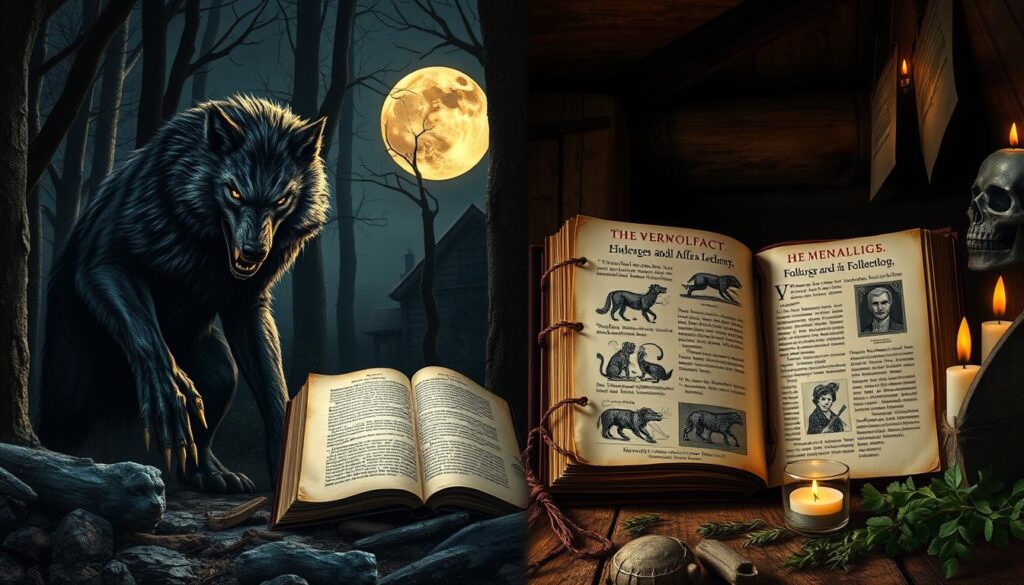
“Werewolves remain firmly in the realm of myth and fiction, captivating our imagination but lacking any solid evidence of their real-world existence.”
The Werewolf Trials and Executions
Many know about the witch trials of the 16th and 17th centuries. But, not many know that werewolves were also persecuted and executed back then. In France, people believed witches could turn into wolves, known as “loup-garous.” This led to many being burned at the stake for being accused of being werewolves.
These trials and executions of werewolves lasted into the 18th century in some places. They even went beyond the witch trials. A famous case was Peter Stumpp, a German farmer called the “Werewolf of Bedburg,” who was executed in 1589 for his supposed crimes.
The Persecution of Accused Werewolves
Historians say up to 30,000 people were executed as werewolves in France from 1520 to 1630. But, historian Willem de Blécourt believes this number might be too high. He thinks the real number of werewolves tried in Europe was only a few hundred.
Still, the werewolf witch trials were a big deal. They started in Switzerland in the 15th century and spread across Europe, peaking in the 17th century. France had many werewolf trials in the late 16th century, with accusations of murder and cannibalism. Other places like Livonia and the Netherlands also had their own werewolf trials and executions.
“The practice of convicting, torturing, and executing individuals for the crime of lycanthropy, or werewolfism, lasted well into the 18th century in some areas, and was often more prevalent than the witch trials.”
Why Do People Believe in Werewolves?
People have always been drawn to werewolves, and it’s not just for fun. The mystery around these creatures comes from not understanding them in the past. When we couldn’t explain strange violence or odd events, we often blamed mythical creatures like werewolves.
Conditions like hypertrichosis, which makes people grow too much hair, or skin issues from sunlight, could be seen as signs of werewolf transformations. Our need to explain the unknown and fear losing control over ourselves or giving in to our wild side drives the psychology of werewolf beliefs.
Even with more science today, werewolf superstitions still capture our imaginations. The 1941 film “The Wolf Man” helped shape our modern views on werewolves, like their weakness to silver and how they change under a full moon. This movie has made werewolves a big part of our culture.
Though werewolves are unlikely to be real, their legend shows our deep interest in the unknown. It also highlights our fascination with the two sides of human nature – our civilized side and our wild instincts.
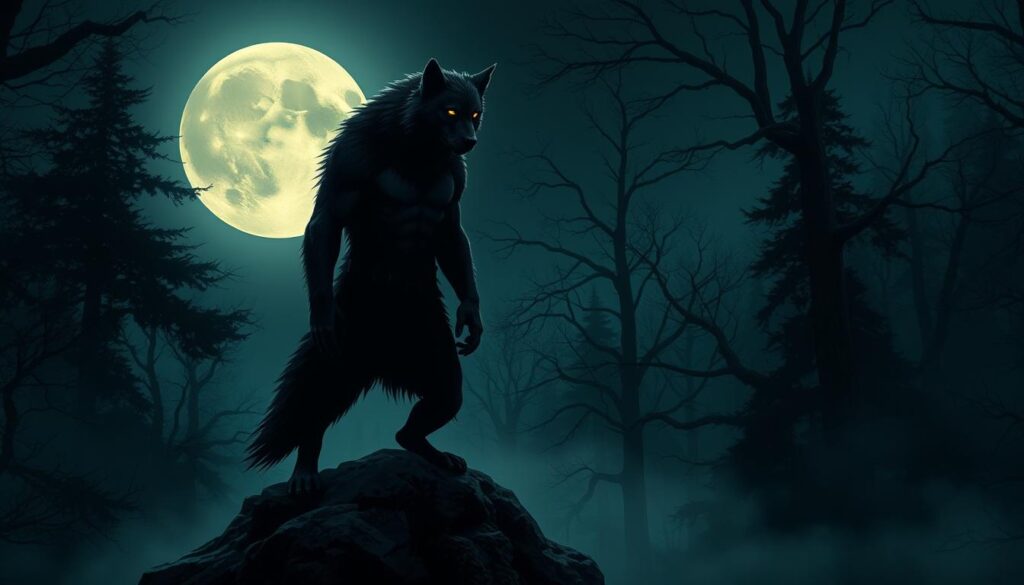
“The enduring myth of werewolves is linked to human nature’s attempt to understand the unexplainable and the fear of losing control over one’s actions.”
Separating Werewolf Fact from Fiction
For centuries, werewolves have been a big part of stories and legends. But the way we see them today, especially in movies and TV, comes from the 1941 film “The Wolf Man.” Before that, stories didn’t focus as much on turning into a wolf. Instead, people talked about changing into different animals.
Experts say if werewolves were real, they wouldn’t be like the ones in movies. It’s important to know the real history and origins of werewolf stories. This helps us understand these mythical creatures better.
- Modern wolf research started in the 20th century, with a big study in 1944.
- Since 1944, we’ve learned everything we know about real wolves, clearing up old myths.
- In reality, “lone wolves” aren’t as scary as movie versions. They mostly eat small animals like squirrels.
- Alone, wolves don’t hunt well and don’t live as long as those in packs.
- Stories of werewolf trials, like Peter Stumpp in 1589 and the “Werewolf of Dole” in France, show how fear led to wrongfully accused people.
Today, we still hear about werewolf-like creatures, but it’s key to know the difference between werewolf facts vs. fiction. The stories of werewolves in movies and books show our interest in the line between being human and being wild. But the truth is, werewolves are just myths.
“The real werewolf is not a bloodthirsty, savage beast, but a complex mythical creature that reflects our own human struggles with the primal aspects of our nature.”
Medical Conditions Linked to Werewolf Legends
Werewolves may seem like myths, but some rare medical conditions could have inspired these legends. Conditions like hypertrichosis and porphyria have symptoms that might have been seen as werewolf traits in the past.
Rare Disorders and Werewolf Myths
Hypertrichosis is a condition where people grow too much hair. It’s very rare, with fewer than 100 cases known since the Middle Ages. Scientists only figured out the cause after studying it for nearly 20 years.
Porphyria is a blood disorder that can make people sensitive to sunlight and cause red teeth. These symptoms might have led people to believe in werewolves. In 1963, a doctor even linked werewolf stories to porphyria.
Psychiatric disorders that make people think they can turn into animals are also linked to werewolf myths. These conditions are usually related to serious mental health issues, not magic.
| Condition | Potential Link to Werewolf Myths | Prevalence |
|---|---|---|
| Hypertrichosis | Excessive hair growth | Fewer than 100 documented cases since the Middle Ages |
| Porphyria | Photosensitivity, reddish teeth | Varies by type, but generally considered rare |
| Clinical Lycanthropy | Delusions of animal transformation | Extremely rare, typically linked to psychiatric disorders |
These medical conditions don’t involve shape-shifting at all. They show how not knowing about science in the past led people to believe in werewolves.
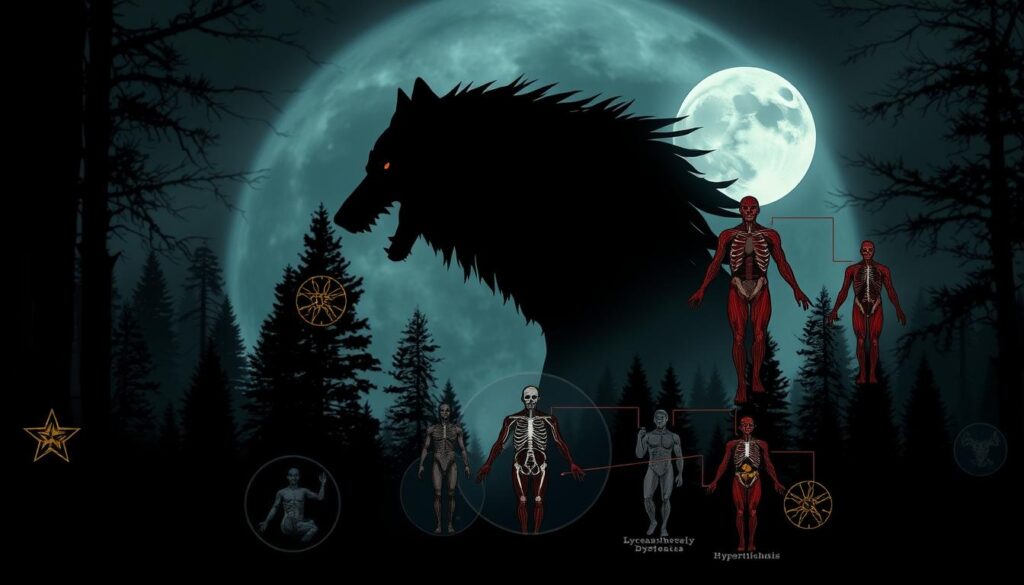
Cultural Significance of Werewolf Stories
Werewolf stories have been important in culture for a long time. They let us see our deep fears and dark sides. These tales warn us about losing control of our wild instincts. Werewolves and other monsters help us understand our complex nature.
These creatures let us face the unknown and the mysterious. They show our interest in what lies between the natural and the supernatural. The cultural significance of werewolf myths and the role of werewolf legends have changed over time. What causes someone to turn into a werewolf has changed from devil magic to genetics or being bitten.
The first stories about werewolves were around 2100 B.C. in the Epic of Gilgamesh. It told of a shepherd who turned into a wolf. In 425 B.C., Herodotus wrote about a tribe that could turn into wolves.
Plato, around 380 B.C., told a story about a king named Lycaon who became a wolf-human mix by Zeus.
In European folklore, people believed in werewolves during the Middle Ages, even when it was called witchcraft. In the 15th and 16th centuries, there were cases of alleged werewolves in Europe. This led to executions and confinements based on werewolf claims.
“The concept of werewolves dates back to around 2100 BC and is rooted in historical and mythological narratives.”
Today, werewolf stories are still popular in books and movies. They show our ongoing interest in the werewolf myth. The cultural significance of werewolf myths and the role of werewolf legends are key to our imagination. They help us explore what it means to be human and the line between the natural and supernatural.
Modern Interpretations of Werewolves
Werewolf legends go way back, but today’s view of these creatures comes from pop culture. The 1941 film “The Wolf Man” started many werewolf traditions, like needing silver to kill them and changing during the full moon. These ideas have spread through books, movies, and TV shows.
Now, werewolves are a big part of horror and fantasy stories. Their ability to change shape and their wild nature still draws people in. From old classics like “An American Werewolf in London” to newer series like “Twilight,” werewolves in pop culture have changed over time. This shows how stories and tastes have evolved.
Werewolves in Literature, Film, and Television
For thousands of years, werewolf stories have been a big part of our culture. Today, they often clash with vampires, as seen in “Underworld” (2003) and “Van Helsing” (2004). “Teen Wolf” (2011) focuses on werewolves alone, while “Bitten” (2014) brings a new twist by featuring a female werewolf.
“The Wolf Man” has greatly influenced werewolf stories in movies and TV. Curt Siodmak’s 1941 film changed how we see werewolves in movies. Over time, werewolves in films and shows have mostly looked scary and not like real wolves from stories.
The Underworld movies have also changed how we see werewolves today. They used practical effects and animatronics to show different kinds of werewolves. This has made werewolf designs in media more unique, with things like weird legs and looks that don’t really match real wolves.
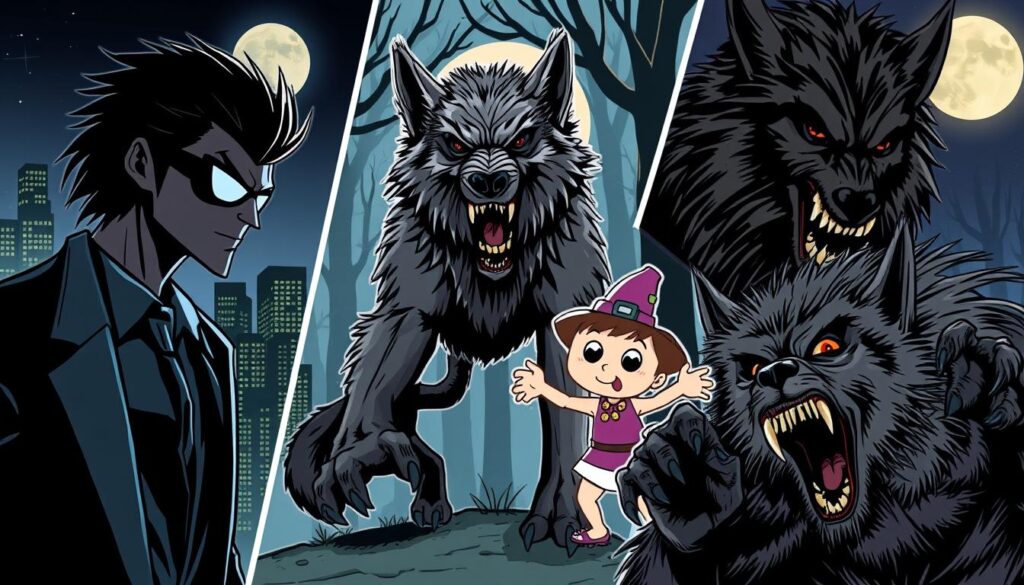
Some movies and games show werewolves without tails, thanks to films like Underworld. This has led many to think werewolves in old stories didn’t have tails. But, leaving out tails in stories can be practical. It’s hard to make tails look real in costumes or CGI because they move and look complicated.
The Enduring Appeal of Werewolf Mythology
The fascination with why werewolves are popular goes way back to ancient times. These myths have been around for centuries, drawing us in with stories of change and the mix of human and animal nature. This mix has made them last through the ages.
These stories started in ancient Greece and Rome, with tales of King Lycaon turning into a wolf. In the Middle Ages, the enduring appeal of werewolf myths grew even more. There was a big wave of fear about werewolves in Europe, leading to many false accusations.
In the 19th and 20th centuries, werewolves became even more famous thanks to Gothic horror stories and movies like “The Wolf Man” (1941) and “An American Werewolf in London” (1981). These movies made werewolves a big part of popular culture. Today, shows like “Teen Wolf” and “True Blood” keep exploring the werewolf’s two sides.
Werewolves capture our interest because they show us the fight to keep our wild side in check. Their story is like a mix of Jekyll and Hyde, showing our deep fears of the beast within us. This makes them a strong symbol of our inner struggles.
“As long as humans grapple with these fundamental questions of our own nature, the werewolf myth is likely to endure in our collective imagination.”
From old stories to today’s movies and TV shows, the enduring appeal of werewolf myths keeps drawing us in. They make us think about big themes like right and wrong, power, being an individual, and the line between humans and animals. As werewolf stories change, they stay a powerful symbol of our fight to keep our wild and tame sides in balance.
Conclusion
Werewolves have been a big part of stories and legends for a long time. The 1941 film “The Wolf Man” greatly influenced how we think of these creatures today. Before this movie, stories about werewolves were more varied, often featuring shape-shifting into different animals, not just wolves.
Experts believe it’s very unlikely that real werewolves exist. Yet, the idea of werewolves still fascinates us. This shows how much we love stories about these mythical beings.
People started believing in werewolves for many reasons. One reason was a lack of understanding of the natural world. Another was our need to explain the unknown. And we’re also drawn to the idea of having two sides to our nature.
Even though werewolves are just in stories, they keep showing up in books, movies, and TV shows. This means they will likely keep capturing our imaginations for a long time.
Looking at werewolf myths and reality, it’s clear they’re not real. But the idea of werewolves stays a big part of our culture. It keeps inspiring and thrilling people all over the world.
FAQ
What are werewolves?
Werewolves are mythical beings that turn into wolves. They have been in stories and legends for centuries. People from different cultures have talked about them.
Where do the origins of werewolf legends come from?
Werewolf stories started in ancient Greek myths. They tell of Lycaon, a cruel king turned into a wolf by Zeus. This story led to the word “lycanthropy,” meaning to change into a wolf.
How did the 1941 film “The Wolf Man” influence modern werewolf depictions?
“The Wolf Man” from 1941 changed how we see werewolves today. It introduced common ideas like needing silver to kill them and becoming one through a bite. It also linked the full moon to their transformations.
Are there real werewolves?
Experts say real werewolves are unlikely. The idea of humans changing into wolves is fascinating but not supported by science. If werewolves existed, they would likely be very different from movie and book descriptions.
What was the persecution of accused werewolves like during the witch trials?
During the witch hunts, people believed witches could turn into wolves. Many were burned at the stake for being accused. This belief led to the torture and execution of many, lasting into the 18th century.
Why do people believe in werewolves?
People believed in werewolves because they didn’t understand the world well in the past. Unexplained violence was often blamed on mythical creatures. Our fear of losing control and our deep fears drive the werewolf legend.
How have medical conditions contributed to werewolf legends?
Some medical conditions, like too much hair or sensitivity to sunlight, were thought to be signs of werewolfism. Mental health issues that make people think they’re animals also added to the myths.
Why do werewolf stories and legends hold cultural significance?
Werewolf tales help us understand our darker sides. They warn us about losing control. These stories show the struggle between our civilized and wild selves.
How have werewolves been depicted in modern pop culture?
Werewolves are now a big part of horror and fantasy. Their ability to change and their wild nature keep drawing people in. This is seen in old horror movies and new series like “Twilight.”
Why does the werewolf myth continue to endure?
We’re still drawn to werewolf stories because they reflect our own nature. The idea of changing into something else shows our struggle with our wild side. This struggle makes werewolf tales popular.

